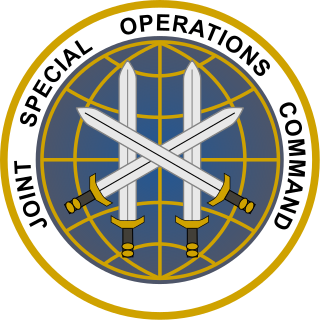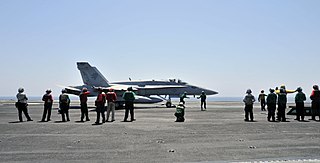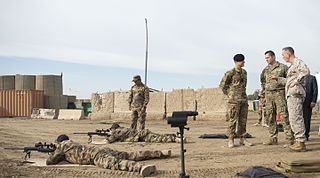
The United States Central Command is one of the eleven unified combatant commands of the U.S. Department of Defense. It was established in 1983, taking over the previous responsibilities of the Rapid Deployment Joint Task Force (RDJTF).

King Abdullah II Special Forces Group, commonly known as the JORSOF are strategic-level special forces of the Royal Jordanian Army under the Jordanian Armed Forces. Founded on April 15, 1963, on the orders of the late King Hussein, its primary roles include reconnaissance, counter-terrorism, search and evacuation, intelligence gathering combat, and the protection of key sites. The Special Forces Group are also charged with carrying out precision strikes against critical enemy targets. The unit is equipped and trained to be able to operate behind enemy lines for long periods without any logistical support, and is considered some of the best in the Middle East.

The Joint Special Operations Command (JSOC) is a joint component command of the United States Special Operations Command (USSOCOM) and is charged with studying special operations requirements and techniques to ensure interoperability and equipment standardization, to plan and conduct special operations exercises and training, to develop joint special operations tactics, and to execute special operations missions worldwide. It was established in 1980 on recommendation of Colonel Charlie Beckwith, in the aftermath of the failure of Operation Eagle Claw. It is headquartered at Pope Field.

The Royal Jordanian Army is the ground force branch of the Jordanian Armed Forces (JAF). It draws its origins from units such as the Arab Legion, formed in the British Mandate of Transjordan in the 1920s. It has seen combat against Israel in 1948, 1956, 1967, and 1973. The Army also fought the Syrians and the PLO during Black September in 1970.
Ziad Khalaf al-Karbouly, a native of Al-Qa'im, was an Islamist former Iraqi officer and the son of an Iraqi tribal sheikh of the Al-Karabla clan of the Dulaim.

The Directorate of Military Intelligence is the military intelligence branch of the Defence Forces, the Irish armed forces, and the national intelligence service of Ireland. The organisation has responsibility for the safety and security of the Irish Defence Forces, its personnel, and supporting the national security of Ireland. The directorate operates domestic and foreign intelligence sections, providing intelligence to the Government of Ireland concerning threats to the security of the state and the national interest from internal and external sources.

The Islamic State (IS), also known as the Islamic State of Iraq and the Levant (ISIL), the Islamic State of Iraq and Syria (ISIS) and by its Arabic acronym Daesh, is a transnational Salafi jihadist group and a former unrecognised quasi-state. Its origins were in the Jai'sh al-Taifa al-Mansurah organization founded by Abu Omar al-Baghdadi in 2004, which fought alongside al-Qaeda during the Iraqi insurgency. The group gained global prominence in 2014, when its militants successfully captured large territories in northwestern Iraq and eastern Syria, taking advantage of the ongoing Syrian civil war. By the end of 2015, it ruled an area with an estimated population of twelve million people, where it enforced its extremist interpretation of Islamic law, managed an annual budget exceeding US$1 billion, and commanded more than 30,000 fighters.
The term Special Missions Unit (SMU), at one time referred to as a "Tier 1" unit, is used in the United States to categorize the nation's most highly secretive and elite military special operations forces. The term "special missions unit" is also used in Australia to describe the Special Air Service Regiment. Special mission units have been involved in high-profile military operations, such as the killing of Osama bin Laden and the attempted hostage rescue of Kayla Mueller.
The Counter Terrorism Service is a special operations force of Iraq. The Agency was founded in 2007, but originally was created in 1950, but was disbanded and recruited from scratch by the United States federal government after the 2003 U.S. invasion. It was originally known as the Iraqi Special Operations Forces (ISOF). The forces, directed by the Iraqi Counter Terrorism Service, consist of the Iraqi Counter Terrorism Command, which has three brigades subordinate to it. The Counter Terrorism Service is funded by the Iraqi Ministry of Defence.

65th Airborne Special Forces Brigade, or the NOHED Brigade, is an airborne, special forces unit of the Iranian Army established in 1959.

Many states began to intervene against the Islamic State, in both the Syrian Civil War and the War in Iraq (2013–2017), in response to its rapid territorial gains from its 2014 Northern Iraq offensives, universally condemned executions, human rights abuses and the fear of further spillovers of the Syrian Civil War. These efforts are called the war against the Islamic State, or the war against ISIS. In later years, there were also minor interventions by some states against IS-affiliated groups in Nigeria and Libya. All these efforts significantly degraded the Islamic State's capabilities by around 2019–2020. While moderate fighting continues in Syria, as of 2024, ISIS has been contained to a manageably small area and force capability.

On 15 June 2014, U.S. President Barack Obama ordered United States forces to be dispatched in response to the Northern Iraq offensive of the Islamic State (IS) as part of Operation Inherent Resolve. At the invitation of the Iraqi government, American troops went to assess Iraqi forces and the threat posed by ISIL.

Operation Inherent Resolve (OIR) is the United States military's operational name for the international war against the Islamic State, including both a campaign in Iraq and a campaign in Syria, with a closely related campaign in Libya. Through 18 September 2018, the U.S. Army's III Armored Corps was responsible for Combined Joint Task Force – Operation Inherent Resolve (CJTF—OIR) and were replaced by the XVIII Airborne Corps. The campaign is primarily waged by American and British forces in support of local allies, most prominently the Iraqi security forces and Syrian Democratic Forces (SDF). Combat ground troops, mostly special forces, infantry, and artillery have also been deployed, especially in Iraq. Of the airstrikes, 70% have been conducted by the military of the United States, 20% by the United Kingdom and the remaining 10% being carried out by France, Turkey, Canada, the Netherlands, Denmark, Belgium, Saudi Arabia, the United Arab Emirates, Australia and Jordan.

The Military of the Islamic State is the fighting force of the Islamic State (IS). The total force size at its peak was estimated from tens of thousands to over two hundred thousand. IS's armed forces grew quickly during its territorial expansion in 2014. The IS military, including groups incorporated into it in 2014, openly operates and controls territory in multiple cities in Libya and Nigeria. In October 2016, it conquered the city of Qandala in Puntland, Somalia. It conquered much of eastern Syria and western Iraq in 2014, territory it lost finally only in 2019. It also has had border clashes with and made incursions into Lebanon, Iran, and Jordan. IS-linked groups operate in Algeria, Pakistan, the Philippines, and in West Africa. In January 2015, IS was also confirmed to have a military presence in Afghanistan and in Yemen.

Muath Safi Yousef al-Kasasbeh was a Jordanian fighter pilot who was captured and burned to death by the militant group ISIL after his F-16 fighter aircraft crashed over Syria.

The Jordanian military intervention in the Syrian Civil War began on 22 September 2014, with airstrikes on Islamic State of Iraq and the Levant (ISIL) targets, and escalated after the murder of Muath al-Kasasbeh, a Jordanian pilot who was captured by ISIL when his F-16 Fighter Jet crashed over Syria in early 2015. Though Jordan's strikes in Syria largely tapered off after December 2015, airstrikes have continued through February 2017, and Jordan has continued to support rebel groups in Syria and host military activities of other countries.

The Palmyra offensive of May 2015 was a military operation launched during the Syrian Civil War by the Islamic State of Iraq and the Levant (ISIL) on May 13–26, 2015, in an attempt to capture the government-held Tadmur District of the Homs Governorate, including the administrative centre of Tadmur, known in English as Palmyra. The ruins and ancient monuments of Palmyra, which lie on the south-western fringe of the modern city, have been a UNESCO World Heritage Site since 1980. The ruins were part of a desert oasis that was one of the most significant cultural centers of the ancient world, linking the civilizations of Persia, India, China with the Roman Empire through trade. The offensive was one of the largest offensives launched by ISIL, the largest one conducted by ISIL in Syria since the 2014 Eastern Syria offensive, with the result of the offensive increasing ISIL's control of Syria to at least 50%.

On 18 December 2016, a series of shootings took place in the city of Al-Karak in southern Jordan. The attack started in the vicinity of Al-Karak where a group of unidentified militants ambushed emergency responders and then moved into the city, attacking police patrols and the local police station and finally seeking shelter in the historic Crusader-era Kerak Castle, a popular tourist attraction.
Captain Harith Al-Sudani was an Iraqi soldier, spy and war hero during the War in Iraq (2013–2017). Al-Sudani infiltrated ISIS, becoming a trustee and car-bombs driver, allowing the Iraqi military to neutralize around 30 car-bomb attacks. Al-Sudani have been described as "[Iraq]'s most successful spy" while operating within the secret intelligence unit called Al Suquor, or the Falcons Intelligence Cell, the counter-terrorism unit leading operations against ISIS. The Falcons have been praised by US services for infiltrating IS cells, killing or arresting leaders, preventing attacks and destroying weapons.

Operation Gallant Phoenix (OGP) is an intelligence fusion centre established in 2013 near Amman, Jordan. It comprises a large number of countries and includes a variety of agencies, including law enforcement, military and civilian personnel, about a total of 250 personnel monitoring. It enhances the ability of member nations' to understand and respond to current, evolving and future violent extremist threats - regardless of threat ideology. Gallant Phoenix allows allied nations not only to share intelligence on the foreign fighter threat, but also to get that information back to their law enforcement and homeland security agencies so they have visibility on the movement of foreign fighters in order to deal with this challenge.
















